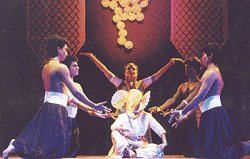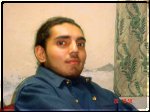 |
 |
ARANGHAM BRINGS CULTURE
COUNCIL TO LIFE
February 2002 |
 |
| Known
for its academic excellence (and also for its administrative hiccups!),
Delhi University heralded the rejenuvation of its cultural leaf,
The Culture Council. To mark this occasion, a one day Cultural Confluence
was organized at Delhi University’s renovated Shankar Lal Hall on
20th Feburary, 2002. This celebration of creativity got a momentous start
with an aesthetically appealing performance by Anita Ratnam’s Arangham.
Arangham – The Arena of Artistry - made a dent in the minds of rasikas as it allowed them to peep into its different dance productions, stitched together in the form of 10-30 minutes capsules each. Of the four productions, Framework, for its highly imaginative and intellectually sharp idea, and Gajaanana, for its fullness, need special mention. Framework was essentially centered around the process of decentering. It involved a process of diffusing the energy of the centre and (re)invigorating this energy in the corners and the edges. The moot idea being, displacing the attention of the audience from the centre, leaving that space open and silent, and painting the ends of the stage with the flow of movements. Framework was performed with the natural music of hands and feet of the dancers. The geometric patterns and sequences were astute and artistic. This is particularly so, because the six dancers did not allow the centre to be conquered by either of them. It remained opened to all and beyond anyone’s domain. The real excellence, was however still elusive and it was achieved with Gajaanana – The God of Good Things. True to its name, Gajaanana is one of the most unique choreographies witnessed in recent times, thanks to the sheer size of the territory of its operation and effect. It brought together Bharatanatyam with the Tamil Folk traditions of Terukoothu and Tappattam and also, Kerala’s Kalari and Yoga. The fusion was homogeneous and it came across as one of the best alternatives that can be tested to preserve and perhaps, recycle the folk dance traditions. The music combined of vedic chanting, drum syllables or the Chollu kattu and also the elements of Kauthavum and Shabdam from the traditional Bhartanatyam repertoire. The costumes, jewellery and masks were designed and created with the help of the student from National Institute of Design, Ahmedabad who worked closely with the craftsmen of Tamil Nadu for a period of one year! This was however, what went behind the making of this production. On stage, these things were shadowed by the brilliant and controlled performances by the dancers. Gajaanana also reflected the deeper and contemporary aspects of Female Creation. In fact, this has been a topic of sharp debate undertaken by the Feminists. Moreover, in recent times, a lot of stress has been paid to the understanding of the intricate relationship between the Woman and her Womb-the Right of Birth and Abortion. How important is – ‘ Her’ seat of creation for Woman. In the myths and legends, the area of Female Operation was her home and her motherhood was her identity- In that respect, her Children. Thus, her achievement was her progeny. Since Goddesses represent the various forms of female power, Parvati’s creativity ,energy and power lies in her creation of nature and beings, of life all around and also, in this case-The birth and Growth of Ganesha! This was superbly captured by Anita Ratnam in her sensitive portrayal of the mother. It assumed significance, because it depicted Shiva’s inexplicable and inexcusable absence from the Kailash and the resulting frustration (one would be correct in saying, the physical longing) and loneliness of Parvati. Thus, the period in which Parvati created Ganesha, was certainly not the one where she was in her best frame of mind. It stemmed from the need to have someone who is a part of her body and thus, existence. Someone, who could be her own and not vanish like Shiva. Therefore, understanding these thought processes and then portraying the role on stage was a tough task but Anita Ratnam did justice to it. It may not be a sort of exaggeration if one were to say that this production is also apt for the Mother’s day, as it re-establishes the sacred bond with the mother and her child, and something which places the father outside the boundary. The depiction of the young Ganesha was indeed done with gut involvement by a dancer-student. The vibration between the two artistes was very positive and hence it struck an instant rapport with the audience. The in-between
narratives by Anita Ratnam was another highpoint of the production. Generally,
it’s the clarity of voice and subject, which does the trick. In her case,
the added charm of melodious singing left people spell-bound. In
fact, her alertness on stage came out starkly when during the movements
portraying the creation of Ganesha, her Mic-set fell of. She did
not cut short the space she was creating and, picked up and adjusted the
Mic-Set in a way, that it looked a part of the movement itself!
Even as a member
of the audience shared his views on the production and found it somewhat
repetitive towards the end, this writer could not help but disagree with
him, at that moment!
|
 |
Delhi
based Lada Guruden Singh is a young Bharatanatyam dancer. A budding poet,
he has to his credit a collection of poems, entitled Split Ends. Lada envisages
a conscious role play for himself in the realm of Dance and Art related
issues in years to come.
e-mail: ladasinghg@yahoo.com |